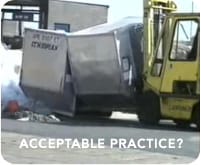Cargo Terminals, Freight Forwarders, CARE, Ground Handlers, ULD Service providers, Movement
Policy on ULD and the Use of Forklifts
In recent weeks, the IATA ULD Panel was asked to provide input regarding ULD facilities.
The request came from another section of IATA, the section responsible for producing the Airport Development Reference Manual, an IATA publication used in the planning of future airports.
Given a nice clear sheet of paper, the views of some members were pretty clear that any airport of the future should be “forklift free” as far as ULD’s are concerned, but others expressed the view that the use of forklifts around ULD’s seemed to be unavoidable, that it was unrealistic to set the bar too high, and that there should be some allowances for the use of forklifts.
After considerable debate by emails, followed by a face to face meeting in Cologne in early April, it was agreed that airports of the future should be designed and constructed in such a manner that ULD’s can truly be operated in a manner that does not require direct application of a forklift to a ULD, with the exception of course of forkliftable ULD’s, should they still exist in this far distant future. This discussion however raises interesting perspectives around the apparent inevitable use of forklifts to move ULD in ground operations which seems worthy of a ULD CARE newsletter article.
Looking back at the early days of ULD in the ‘70’s, many airlines’ ULD’s were of the forkliftable base type. Couple this with the far more limited use of pallets in those days and it’s not hard to see how ground facilities were often set up assuming that it was acceptable to use forklifts as a primary mover of ULD’s.
Since then ULD’s have changed with the forklift base container being very much an exception. Meanwhile, the use of pallets has become widespread (probably 50% of all ULD’s are pallets) and yet somehow, the ground handling/cargo terminal/freight forwarding industry failed to adapt to this change, continuing in all too many instances to use forklifts as a primary means of ULD movement in their facilities. Add into this equation the move to lighter ULD and you have all the ingredients for excessive ULD damage, as evidenced by a trip to any ULD repair shop not to mention a discussion on annual repair costs with any ULD owner.

Along come the IATA ULD Regulations, providing a good number of ”Do’s” and “Don’ts” for anyone working with ULD’s, including the use of forklifts. While many in the industry have welcomed the arrival of the ULDR’s, its impact is yet to be widely felt. There is also a reluctance from non ULD owners, who have up till now been able to operate without any conditions, to take the ULDR’s on board, choosing to assume that these regulations are too harsh and that “we can’t adopt them without incurring huge costs”. The reality of the ULD Regulations is that in fact they are entirely reasonable in the approach towards handling ULD on the ground, derived from the principle that they were drafted and reviewed by people from all sides of the industry whose views were all taken into account.
Section 9 of the ULDR provides detailed guidance on all aspects of ULD Handling, with Sections 9.3 and 9.4 being probably the most relevant to forklift use. To simplify this for our readers the table below illustrates the position of the ULDR’s on the different types of ULD in the different processes with Green being OK for forklift use, Orange being OK for forklift use with strict limitations and Red being NO GO as far as the use of forklifts is concerned.

The table clarifies and illustrates the basic principles:
- Any forkliftable ULD may be handled with forklift all the time
- Any loaded standard base container and any pallet must NEVER be moved by forklift when loaded
- Empty pallets and standard base containers may be moved by forklifts when EMPTY and may be stored temporarily if necessary outside standard specification ULD racking.
So is this unreasonable? Hardly!
The forklifting of a loaded standard base container or a loaded pallet is always going to cause damage, if not obvious and immediate then hidden in things like missing rivets or bent structure which cause future problems. This practice is clearly never permissible.
The storage of ULD outside recommended racking fitted with roller beds is also permitted on a temporary basis subject to certain conditions. As it is inevitable that the use of such temporary storage will involve handling by forklift the ULDR’s contain a number of very reasonable requirements to be observed if this practice is followed.
Any then there is the use of forklifts to move both empty pallets and standard base containers as well as to move forklift base containers empty or loaded. All these procedures are permitted under the ULDR provided that proper care is paid to ensure that ULD’s are not damaged.
Reasonable? ……Yes
Observed? …. Mostly not, as evidenced by annual global repairs of ULD in the US$ hundreds of millions.
The IATA ULD Regulations do not banish forklifts, instead they provide clear guidance as to when and how forklifts may be used around ULD, creating a standard for the air cargo industry that protects the assets of ULD Owners and permits the carrying out of cargo operations in a practical manner.


